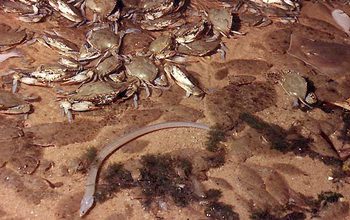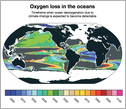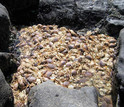Hola amigos: A VUELO DE UN QUINDE EL BLOG., hemos recibido información de la Fundación Nacional de Ciencias de Los Estados Unidos, sobre las evidencias de la pérdida de oxígeno en los océanos en el década del 2,030, nos dice: "El cambio climático ha provocado una caída en la cantidad de oxígeno disuelto en los océanos en algunas partes del mundo, y esos efectos debería ser evidente a través de grandes partes del océano entre 2030 y 2040, según un nuevo estudio dirigido por investigadores del Centro Nacional de Investigación atmosférica (NCAR) en Boulder, Colorado.Los científicos espera que el calentamiento global a los océanos de la savia de oxígeno, dejando de pescado, cangrejos, calamares, estrellas de mar y otras especies marinas luchando por respirar. Pero habían encontrado dificultades para determinar si esta fuga de oxígeno anticipado ya estaba teniendo un efecto notable."La pérdida de oxígeno en los océanos es uno de los efectos secundarios graves de calentamiento de la atmósfera, y una amenaza para la vida marina", dijo el científico del NCAR Mateo largo, autor principal del estudio. "Dado que las concentraciones de oxígeno en el océano varía naturalmente dependiendo de las variaciones en los vientos y la temperatura en la superficie, que ha sido un reto para atribuir cualquier desoxigenación al cambio climático. Este nuevo estudio nos dice cuándo podemos esperar el efecto del cambio climático para abrumar a la variabilidad natural ".
More information.........
Deoxygenation due to climate change threatens marine life
 Credit and Larger Version |
Climate change has caused a drop in the amount of oxygen dissolved in the oceans in some parts of the world, and those effects should become evident across large parts of the ocean between 2030 and 2040, according to a new study led by researchers at the National Center for Atmospheric Research (NCAR) in Boulder, Colorado.
Scientists expected a warming climate to sap oceans of oxygen, leaving fish, crabs, squid, sea stars, and other marine life struggling to breathe. But they had encountered difficulties in determining whether this anticipated oxygen drain was already having a noticeable effect.
"Loss of oxygen in the oceans is one of the serious side effects of a warming atmosphere, and a major threat to marine life," said NCAR scientist Matthew Long, lead author of the study. “Since oxygen concentrations in the ocean naturally vary depending on variations in winds and temperature at the surface, it's been challenging to attribute any deoxygenation to climate change. This new study tells us when we can expect the effect from climate change to overwhelm the natural variability."
The study is published in the American Geophysical Union journal Global Biogeochemical Cycles. The research was funded by the National Science Foundation (NSF).
Cutting through the natural variability
The entire ocean -- from the depths to the shallows -- gets its oxygen supply from the surface, either from the atmosphere or from phytoplankton, which release oxygen into the water through photosynthesis.
Warming surface waters, however, absorb less oxygen. And, in a double whammy, the absorbed oxygen has a more difficult time traveling deeper into the ocean. That's because as water heats up, it expands, becoming lighter than the water below it and less likely to sink.
Thanks to natural warming and cooling, oxygen concentrations at the sea's surface change constantly -- and deeper in the ocean, those changes can linger for years or decades.
For example, an exceptionally cold winter in the North Pacific would allow the ocean surface to soak up a large amount of oxygen. Thanks to the natural circulation pattern, that oxygen would then be carried deeper into the ocean, where it might still be detectable years later as it travels along its flow path.
On the flip side, unusually hot weather could lead to "dead zones" in the ocean, where fish and other marine life cannot survive.
To cut through this natural variability and investigate the impact of climate change, the research team -- including Curtis Deutsch of the University of Washington and Taka Ito of Georgia Tech -- relied on the NCAR-based Community Earth System Model, which is funded by NSF and the U.S. Department of Energy.
“This study shows how far comprehensive Earth System Models have come in the effort to quantify, along with relatively sparse observations, large-scale changes in oxygen in the oceans due to both natural variability and climate change,” said Eric Itsweire, program director in NSF's Division of Ocean Sciences.
The scientists used output from a project that ran the model more than two dozen times for the years 1920 to 2100. Each individual run started with miniscule variations in air temperature. As the model runs progressed, those tiny differences grew and expanded, producing a set of climate simulations useful for studying questions about variability and change.
Using the simulations to study dissolved oxygen gave the researchers guidance on the degree to which concentrations may have varied naturally in the past. With this information, they could determine when ocean deoxygenation due to climate change is likely to become more severe than at any point in the modeled historic range.
The researchers found they could already detect deoxygenation caused by climate change in the southern Indian Ocean and parts of the eastern tropical Pacific and Atlantic basins.
They also determined that more widespread detection of deoxygenation caused by climate change would be possible between 2030 and 2040.
However, in some parts of the ocean, including areas off the east coasts of Africa, Australia, and Southeast Asia, deoxygenation caused by climate change would not become evident even by 2100.
Detecting a global pattern
The researchers also created a visual way to distinguish between deoxygenation caused by natural processes and deoxygenation caused by climate change.
Using the same model dataset, the scientists created maps of oxygen levels in the ocean, showing which waters were oxygen-rich and which were oxygen-poor. They found they could distinguish between oxygenation patterns caused by natural weather phenomena and the pattern caused by climate change.
The climate change pattern also became evident in the model runs around 2030, adding confidence to the conclusion that widespread deoxygenation due to climate change will become detectable around that time.
The maps could also be useful resources for deciding where to place instruments to monitor ocean oxygen levels in the future to get the best picture of climate change effects. Currently, ocean oxygen measurements are relatively sparse.
"We need comprehensive and sustained observations of what's going on in the oceans to compare with what we're learning from our models, and to understand the full effect of a changing climate," Long said.
-NSF-
Media Contacts Cheryl Dybas, NSF, (703) 292-7734, cdybas@nsf.gov
David Hosansky, NCAR, (303) 497-8611, hosansky@ucar.edu
The National Science Foundation (NSF) is an independent federal agency that supports fundamental research and education across all fields of science and engineering. In fiscal year (FY) 2016, its budget is $7.5 billion. NSF funds reach all 50 states through grants to nearly 2,000 colleges, universities and other institutions. Each year, NSF receives more than 48,000 competitive proposals for funding and makes about 12,000 new funding awards. NSF also awards about $626 million in professional and service contracts yearly.
Useful NSF Web Sites:
NSF Home Page:
http://www.nsf.gov
NSF News:
http://www.nsf.gov/news/
For the News Media:
http://www.nsf.gov/news/newsroom.jsp
Science and Engineering Statistics:
http://www.nsf.gov/statistics/
Awards Searches:
http://www.nsf.gov/awardsearch/

By the 2030s, declining oxygen levels will likely be evident in many of the world's oceans.
Credit and Larger Version

How will species such as crabs fare in low oxygen seas? Scientists are working to find answers.
Credit and Larger Version

Dungeness crabs washed up on a beach in Oregon after suffocating in low-oxygen waters.
Credit and Larger Version

In ocean waters with less oxygen, fish kills are common.
Credit and Larger Version

Declining cod stocks may be further threatened by waters with low oxygen.
Credit and Larger Version
The National Science Foundation (NSF)
Guillermo Gonzalo Sánchez Achutegui
ayabaca@gmail.com
ayabaca@hotmail.com
ayabaca@yahoo.com
Inscríbete en el Foro del blog y participa : A Vuelo De Un Quinde - El Foro!

No hay comentarios:
Publicar un comentario